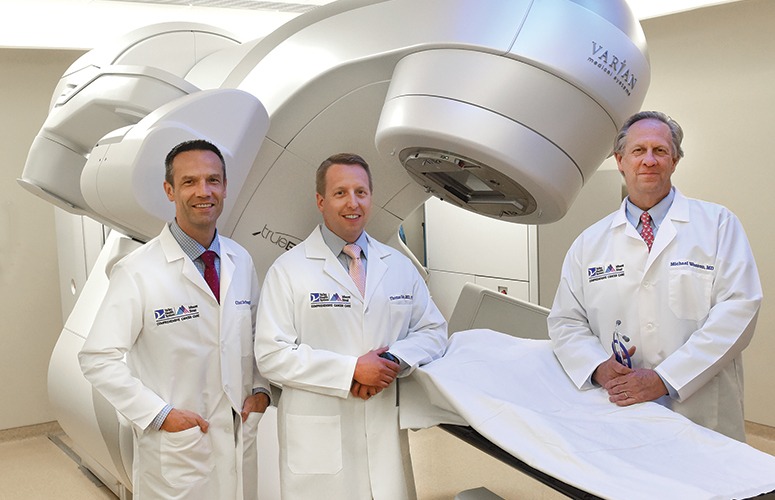
Hospitals Pursue Technologies for Safer Cancer Treatment
Cancer patients are finding they can access world-class treatment without leaving the state.
By Joe Cavaluzzi, Contributing Writer On Dec 7, 2018Doctors throughout the United States will report approximately 1,735,350 new cancer cases in 2018, and 609,640 people will die at a rate of 1,670 per day, according to the American Cancer Society. In New Jersey – which ranks as the 11th highest state for both total new cases and cancer deaths – the society predicts 53,260 new cancer diagnoses this year. Thirty percent of those diagnoses will prove to be fatal. The anticipated death toll from cancer in the state for 2018 is 16,040, or 50 deaths per day.
State rankings for new cases and cancer deaths can be misleading, as they tend to follow population size. However, there is no disputing the financial and personal toll of cancer. The National Cancer Institute estimates expenditures for cancer care in the US reached $147.3 billion in 2017. The institute anticipates cancer treatment costs will increase over time as the population ages, cancer prevalence increases, and healthcare institutions adopt new and often more expensive treatments. In fact, experts expect the number of cancer survivors to reach to 20.3 million by 2026.
In New Jersey, these survivors and those just diagnosed with cancer are finding many of the latest technology-driven treatments without having to leave the state as hospitals employ innovative tools to diagnose and treat the disease with less intrusive approaches. Below is just a sample of the new methods they offer.
Diagnosing with Precision
At Memorial Sloan Kettering Cancer Care’s Marie-Josée and Henry R. Kravis Center for Molecular Oncology, researchers are studying how the formation and progression of tumors can be traced back to DNA mutations in important genes related to cell growth and division. Most mutations important for cancer are acquired during a person’s lifetime and only found in cells belonging to the tumor. This makes them appealing drug targets because a drug that can selectively kill cells with the mutation, but spare healthy cells, has potential for therapy with fewer side effects.
“We developed a DNA sequencing test called MSK-IMPACT that includes more than 400 genes that have implications for the diagnosis, prognosis or treatment of cancer; the test is offered to patients with metastatic cancer to help guide their care,” Geneticist Michael F. Berger, PhD, and the associate director of the Center for Molecular Oncology, says. Memorial Sloan Kettering (MSK) researchers have sequenced DNA from more than 30,000 tumors.
Recent research has shown that genes historically associated with individual tumor types may be mutated in other types of cancer, and that targeted therapies may also be effective in treating other cancers. This is the basis for a new type of clinical trial called a “basket trial” in which all types of cancer with a specific mutation in common are treated with the same targeted drug. MSK is conducting more than a dozen basket trials that rely on MSK-IMPACT testing to identify eligible patients.
“The main focus of our MSK-IMPACT testing has been for patients with metastatic cancer who are eligible to receive targeted therapies or to participate in clinical trials,” Berger says. “But we know that certain genomic mutations may influence the prognosis for a patient’s cancer when it is diagnosed early and could inform decisions about how aggressively they should be treated.”
The DNA mutations identified by MSK-IMPACT can help inform challenging diagnoses. Bergen notes his team uses machine learning (or artificial intelligence) techniques to help predict the type of cancer in an individual tumor from the set of mutations revealed by MSK-IMPACT.
Lessening Radiation Side Effects
Many New Jersey health systems are focusing on ways to precisely and aggressively deliver radiation with fewer negative effects. At CentraState Medical Center in Freehold, radiation oncologists offer several innovative approaches, including SpaceOAR for prostate cancer.
“The field is advancing to become more precise, which enables us to deliver a stronger dose of radiation to tumors in a shorter time with less impact to normal tissue,” Dr. Neesha Rodrigues, a radiation oncologist at CentraState’s Statesir Cancer Center, says. Placed between the prostate and rectum, SpaceOAR (“organ at risk”) hydrogel pushes the rectum out of the high dose radiation region while treating the prostate. “It has been shown to decrease the likelihood of long-term rectal and urinary issues and lower the occurrence of erectile dysfunction. Our goal is not only to eradicate prostate cancer, but also to minimize the long-term effects.”
CentraState’s radiation oncologists also use Deep Inspiration Breath Hold technology to reduce the exposure of the heart to radiation during treatment of tumors in the left breast. By holding a deep breath, the patient expands her lungs to create larger space between the breast and heart. Wearing video goggles, the patient can track her breathing to see when she reaches the target range of inspiration.
CentraState also uses very precise 4D CT scans to pinpoint radiation delivery to organs that move during treatment as a patient breathes.
“Some tumors, such as lung tumors, can be challenging because they move during treatment when the patient breathes,” Dr. Rodrigues says. “During planning, we do a 4D CT planning scan that obtains images at every point during the respiratory cycle. We are able to make sure we are precisely targeting the tumor while keeping the treatment as narrow as possible to protect the surrounding tissue.”
Saint Barnabas Medical Center (SBMC), a RWJBarnabas Health facility in Livingston, uses Vision AlignRT to increase the accuracy of radiation therapy in treating eligible breast cancer patients. AlignRT employs three advanced cameras and computerized software to track the patient’s breathing and other movements during radiation therapy so physicians can quickly pause treatment if a patient moves out of position.
“A recent study showed that AlignRT, in combination with Deep Inspiration Breath Hold, effectively reduces the potential for long-term toxicities to the heart, lungs and other critical structures,” notes Dr. Alison Grann, chair of Radiation Oncology at Saint Barnabas.
The SBMC radiation oncology team also adopts the latest research findings to benefit patients in delivering higher dose radiation treatments over shorter time periods. “In the past, all women who had a lumpectomy needed six weeks of radiation therapy,” Dr. Grann says. “We now have randomized studies demonstrating that after a lumpectomy, radiation can safely be delivered in three to four weeks. With only about 20 percent of breast cancer patients in the US offered shorter courses of radiation therapy, SBMC’s approach enables its doctors to offer this treatment to a higher percentage of its patients.”
Six New Jersey health facilities now offer CyberKnife®, a fully robotic radiation delivery system that greatly reduces the amount of treatment time for a significant number of breast cancer patients to one week, according to Dr. Gopal R. Desai, chair, radiation oncology, at St. Peter’s University Hospital.
“Breast cancer gets diagnosed in early stages 70 to 80 percent of the time. A good proportion of these patients are candidates for CyberKnife. Those who have involvement of the lymph nodes are not candidates,” Dr. Desai says. However, patients who had prior radiation and experience a localized small relapse may be candidates. “The standard treatment is mastectomy. However, CyberKnife offers a reasonable alternative to save the breast and receive therapy.”
At Valley-Mount Sinai Comprehensive Cancer Care, a team of radiation oncologists employs Intraoperative radiation therapy (IORT), a technology that enables doctors to administer a course of radiation therapy to breast cancer patients while they are anesthetized for surgery to remove the cancer.
“This can avoid a course of daily radiation after surgery, which would generally take three-to-seven weeks delivered daily Monday through Friday,” Dr. DeYoung says. “IORT is also associated with less fatigue and sunburn like skin reaction, which is typically seen with traditional radiation.”
Doctors and researchers continue to collect data to determine which patients should receive IORT. Currently, fewer than 10 percent of Valley-Mount Sinai breast cancer patients are considered ideal candidates. “Often times, however, these are elderly or otherwise challenged patients who will benefit from radiation to lower the risk of cancer recurrence in the breast without making daily treatment visits for weeks,” Dr. DeYoung says. He believes Valley-Mount Sinai is the only New Jersey health center currently offering IORT. Clinical trials have demonstrated a 95 to 98 percent rate of successfully keeping the cancer from coming back in the breast at the five-year point. “We are waiting for the data to mature further to verify that this level of success holds up beyond five years,” Dr. DeYoung says.
Less Invasive Surgery
Hackensack University Medical Center, part of the Hackensack Meridian Health System, has acquired the innovative da Vinci single-port (SP) system, a robotic-assisted technology used by surgeons to perform complex urological procedures. Surgeons only need to make a one-inch incision utilizing da Vinci SP, which may cause less stress, shorten recovery time and improve cosmesis. The FDA has approved da Vinci SP for minimally invasive surgery in urologic procedures, including prostate cancer, kidney cancer and advanced urinary tract reconstruction surgery. Doctors at Hackensack University Medical Center anticipate an FDA decision within a year on da Vinci SP use in additional procedures, such as ear, nose and throat and colorectal surgery.
“Hackensack University Medical Center is focused on bringing the most advanced technology and the most experienced surgeons together to constantly improve patient outcomes,” says Dr. Michael Stifelman, chair of urology and director of robotic surgery. “The da Vinci SP technology is transformative as it enables our surgeons to perform the most complex surgeries in the hardest to reach places, using just one small incision.”
New Jersey hospitals continue to participate in research and acquire advanced technologies that are helping cancer patients live longer with higher quality lives. Physicians anticipate these life-saving methods of treating cancer will become more available as their success rates are measured over time.
Related Articles:






